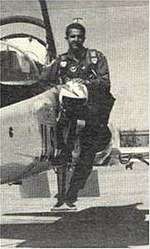Fernando L. Ribas-Dominicci
| Fernando Luis Ribas-Dominicci | |
|---|---|
 Major Fernando Luis Ribas-Dominicci | |
| Born |
June 24, 1952 Utuado, Puerto Rico |
| Died |
April 15, 1986 (aged 33) Gulf of Sidra |
| Place of burial |
San Andres Cemetery Utuado, Puerto Rico |
| Allegiance |
|
| Service/ |
|
| Years of service | 1975–1986 |
| Rank |
Major |
| Unit | 48th Tactical Fighter Wing |
| Battles/wars | Operation El Dorado Canyon |
| Awards |
Purple Heart Air Force Commendation Medal |
Major Fernando Luis Ribas-Dominicci[note 1] (June 24, 1952 – April 15, 1986), was an F-111F pilot in the United States Air Force. He was killed in action during Operation El Dorado Canyon, the April 15, 1986 U.S. air raid on Libya.
Early years
Ribas-Dominicci was born in the town of Utuado, located in the mountains of Puerto Rico where he received his primary and secondary education. As a child, he had always dreamed of becoming a pilot and after he graduated from high school, he entered the University of Puerto Rico at Mayaguez where he earned his Bachelor's degree in civil engineering. As a student in the university, he was a member of the campus' ROTC program and upon graduation was commissioned a Second Lieutenant in the U.S. Air Force.[1]
Military career
Ribas-Dominicci was assigned to Cannon Air Force Base, in New Mexico, where he received advanced training as a General Dynamics F-111 combat pilot. By 1983, Ribas-Dominicci was a Captain and the recipient of the Air Force Commendation Medal. In 1985, he completed his master's degree in aeronautical science at the Embry-Riddle Aeronautical University in Daytona Beach, Florida, USA.[1]
Operation El Dorado Canyon
On April 15, 1986, in response to acts of terrorism sponsored by Libyan leader Muammar al-Gaddafi, the United States attacked key terrorist training facilities in Tripoli, Libya using 18 USAF F-111F fighter-bombers & 5 EF-111A Radar Jamming aircraft from bases in England. The attack was code-named Operation El Dorado Canyon.[2] This was part of a joint strike mission in coordination with US Navy aircraft which struck targets in Behghazi, Libya at the same time. Maj. Ribas-Dominicci was one of the pilots who participated in the air raid as member of the 48th Tactical Fighter Wing. His F-111F was shot down in action over the disputed Gulf of Sidra off the Libyan coast. Ribas-Dominicci and his Weapons Systems Officer (WSO), Capt. Paul F. Lorence, were the only U.S. casualties of the mission.[1][2]
Aftermath
On December 25, 1988, after years of denying that they had the bodies of the two crew members, Gaddafi offered to release the body of Lorence to his family through Pope John Paul II. The body recovered and thought to be that of Lorence was actually that of then-Captain Fernando L. Ribas-Domminici, which was identified by dental records and returned in 1989.[3]
The Libyan government has denied that it holds Lorence's remains and the U.S government does not believe that they are hiding anything.[4] Major Fernando Luis Ribas-Dominicci's remains are buried in his hometown of Utuado.
Honors and legacy
Both men's names are engraved in the F-111 "Vark" Memorial Park located in Clovis, New Mexico. Ribas-Dominicci was awarded the Purple Heart and posthumously promoted to the rank of major, effective April 15, 1986.[5]
To honor his memory, the Government of Puerto Rico renamed the Isla Grande Airport in San Juan to Fernando Ribas Dominicci Airport.[6] The City of Utuado honored its fallen hero by naming a main avenue as Fernando Ribas-Dominicci Avenue. A monument in his honor, simulating an F-111, has been placed at the entrance of Utuado. Ribas-Dominicci's name is engraved in El Monumento de la Recordación (Spanish: Monument of Remembrance) dedicated to Puerto Rico's fallen soldiers and situated in front of the Capitol Building in San Juan, Puerto Rico.
Awards and decorations
Among Major Ribas-Dominicci's military decorations were the following:













Badges
Notes
- ↑ This name uses Spanish naming customs: the first or paternal family name is Ribas and the second or maternal family name is Dominicci.
See also
References
- 1 2 3 "El Dorado Canyon Memorial site". United States Government. Archived from the original on October 25, 2009. Retrieved October 31, 2011.
- 1 2 "In the Dead of the Night". By William R. Doerner;David Halevy and Bruce van Voorst/Washington. Time Magazine. April 28, 1986. Retrieved October 31, 2011.
- ↑ "General: U.S. seeks relations with Liby". By ROBERT BURNS. Magazine. Archived from the original on November 13, 2011. Retrieved October 31, 2011.
- ↑ "Bombing of Libya (1986)". Scribd. Magazine. Retrieved October 31, 2011.
- ↑ "F-111 Aardvark Memorial". Retrieved October 31, 2011.
- ↑ "Fernando Ribas Dominicci Airport". Retrieved October 31, 2011.
Further reading
- Puertorriquenos Who Served With Guts, Glory, and Honor. Fighting to Defend a Nation Not Completely Their Own; by : Greg Boudonck; ISBN 978-1497421837
External links
- Fernando L. Ribas-Dominicci at Find A Grave
- Walter J. Boyne (March 1999). "El Dorado Canyon". Air Force Magazine. 82 (3). Retrieved 2006-11-23.
- Captain Paul Lorence: An American Patriot Left Behind, In 2001, Lorence's lifelong friend, reference librarian Theodore D. Karantsalis, enlisted the aid of Congressman Wally Herger's office to urge Libya to return Lorence's remains on behalf of his family and friends. The Paul Lorence web blog (posted above) was started in 2005 to get the word out around the 20th anniversary of the raid.
- Venkus, Robert E. (1992). Raid On Qaddafi. New York, NY: St. Martin's Press. ISBN 0-312-07073-X.